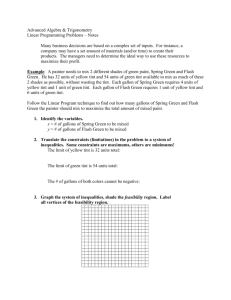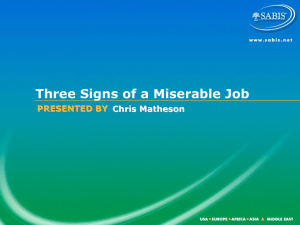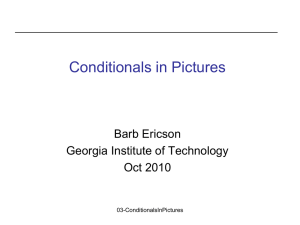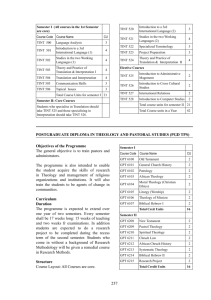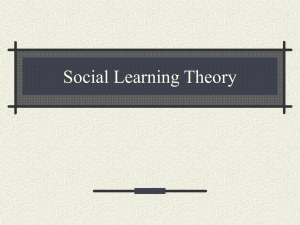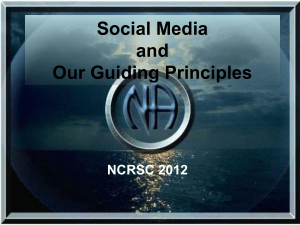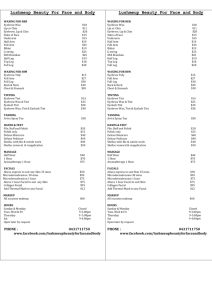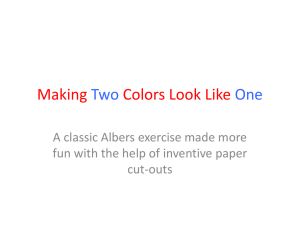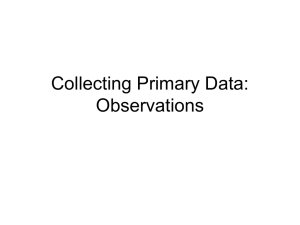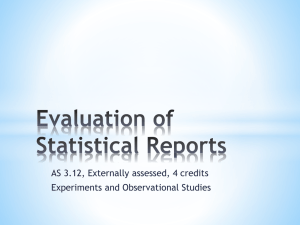Anonymity in Driving Behavior - American Psychological Association
advertisement
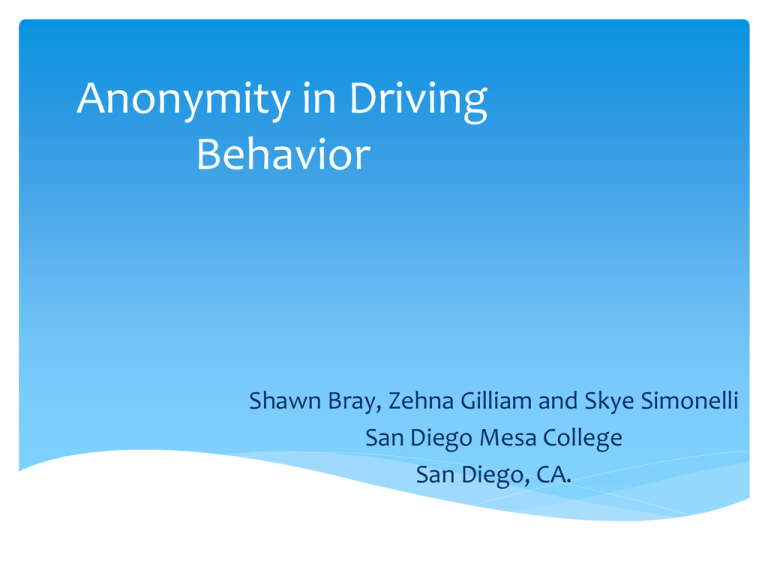
Anonymity in Driving Behavior Shawn Bray, Zehna Gilliam and Skye Simonelli San Diego Mesa College San Diego, CA. Objective To test the effects of anonymity on driving behaviors and to better understand which factors may contribute to other unlawful behaviors. HYPOTHESIS Drivers in automobiles with tinted windows are less likely to make a complete stop at four way stop intersections than drivers in automobiles without tinted windows. KEY TERMS KEY TERMS Observational Study: Researchers observe behaviors under the conditions in which they naturally occur Anonymity: The quality or state of being unknown Disinhibition: A lack of restraint caused by outside factor such as drugs, alcohol, or rioting Anti-Social Behavior: A person has a long-term pattern of manipulating, exploiting, or violating the rights of others Literature Review Literature Review Zimbardo’s (1969) famous electric shock study on the relationship between anonymity and immoral behavior. Ed Diener’s (1976) Halloween study on the effects of being less identifiable by personal information. Andrew Silke’s (2003) analysis of attacks in Northern Ireland, anonymous criminals committed more violent attacks. Literature Review Singer’s (1965) study on less identifiable people being more likely to conform in the Asch (1951) situation. According to Zhong & others (2010), “Even dimmed lighting or wearing sunglasses increases people’s perceived anonymity, and thus their willingness to cheat or behave selfishly.” Patricia Ellison’s (1995) test on anonymity’s effect upon incivility amongst drivers. Methods Methods Observational Study inconspicuous and unobtrusive n = 400 200 tinted cars 200 un-tinted cars 3 different data collection locations Random sample and representative Must make a complete 3 second stop Methods Only cars approaching from the North and South directions Tally in corresponding section of “Stopped/No Stop” and “Tint/NoTint” section of observation chart One researcher at each separate location Selected data collection start time Every other car observed Car must have back tires behind limit line Materials Used Stopped Tint No Tint I No Stop III IIII II Inclusion Criteria One researcher at each separate location Selected data collection start time Every other car observed Car must have back tires behind limit line Observational Definitions and Chart Observational Definitions: Stopped Tint/Stop: TS Tint/No Stop: TNS Tint No Stop I III IIII II No-Tint/Stop: NS No-Tint/No Stop: NN No Tint Observational Location: one Oceanside, CA – 2:30-3:30pm Observational Location: two Encanto, CA – 5:30-7:30pm Observational location: three University City, CA – 11:30-1:30pm Exclusion Criteria Partially rolled down windows Completely rolled down windows Automobiles without doors Convertibles Cars yielding to pedestrians Results Tint No Tint •Stop: 70 •No Stop: 130 Stop: 165 No Stop: 235 •Stop: 95 •No Stop: 105 Results Tinted Windows: 35% did make complete stop 65% did not make a complete stop Un-Tinted Windows: 47.5% did make complete stop 52.5% did not make a complete stop Results Tinted Windows Un-Tinted Windows Stop: 35% Stop: 49% NO Stop: 65% NO Stop: 54% All Cars Stop: 41% NO Stop: 59% DISCUSSION Discussion We supported our hypothesis that drivers of car with tinted windows are less likely to make a complete stop at an intersection. We failed to reject our alternative hypothesis. We have acknowledged that the intent of reckless drivers may not be malicious. Some confounding variables we found: Degree of window tint Contrast in obedience in different socioeconomic areas Discussion Other future studies will include relationships between window tint and: Medical conditions Safety concerns Style preference Overall, we realize that while Deindividuation may not be the cause of getting window tint it is, however, the result. References Anonymity. (2009). In The American Heritage Dictionary of the English Language, Fourth Edition. Retrieved from http://www.thefreedictionary.com/anonymity Berkowitz, L. Some determinants of impulsive aggression: Role of mediated associations with reinforcements for aggression. Psychological Review, 1974, 81, 165-176. Blais MA, Smallwood P, Groves JE, Rivas-Vazquez RA. Personality and personality disorders. In: Stern TA, Rosenbaum JF, Fava M, Biederman J, Rauch SL, eds. Massachusetts General Hospital Comprehensive Clinical Psychiatry. 1st ed. Philadelphia, PA: Elsevier Mosby; 2008: chap 39. References Disinhibition. (n.d.). In Collins English Dictionary - Complete & Unabridged 10th Edition. Retrieved from http://www.thefreedictionary.com/anonymity Festinger, L., Pepitone, A., & Newcomb, T. (1952). Some consequences of deindividuation in a group. Journal of Abnormal & Social Psychology, 47, 382-389. Johnson, R. D., & Downing, L. L. (1979). Deindividuation and valence of cues: Effects on prosocial and antisocial behavior. Journal Of Personality And Social Psychology, 37(9), 1532-1538. doi: 10.1037/0022-3514.37.9.1532. Li, Brian, "The Theories of Deindividuation" (2010). CMC Senior Theses. Paper 12. http://scholarship.claremont.edu/cmc_theses/12 Myers, D. G. (2013). Social Psychology (11th ed.). New York: McGraw-Hill. References Observational Study. (2014). In Stat Trek. Retrieved from http://stattrek.com/statistics/dictionary.aspx?definition=observational_study Singer, J.E., Brush, C.A., and Lublin, S.C. (1965). Some aspects of Deindividuation: Identification and Conformity. Journal of Experimental and Social Psychology, 1, 356-378. Zimbardo, P. G. The human choice: Individuation, reason and order versus deindividuation, impulse, and chaos. In W. J. Arnold, & D. Levinc (Eds.), Nebraska Symposium on Motivation (Vol. 18). Lincoln: University of Nebraska Press, 1970. All images are Microsoft clipart or Google Maps screenshots.
